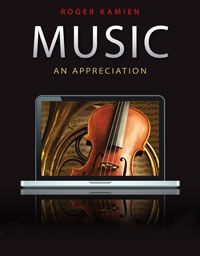
Music: An Appreciation, 10th Edition (Kamien)Chapter 8: Musical TextureInteractive ChapterELEMENTS OF MUSIC: TEXTUREAt a particular moment within a piece, we may hear one unaccompanied melody, several simultaneous melodies, or a melody with supporting chords. To describe these various possibilities, we use the term musical texture; it refers to how many different layers of sound are heard at once, to what kind of layers they are (melody or harmony), and to how they are related to each other. Like fabric, musical texture is described as transparent, dense, thin, thick, heavy, or light. Composers can vary the textures within their music to create contrast and drama. We’ll look now at the three basic musical textures–monophonic, polyphonic, and homophonic. Monophonic Texture The texture of a single melodic line without accompaniment is monophonic, meaning literally havingone sound. If you sing alone, you make monophonic music. Performance of a single melodic line at the same pitch by more than one instrument or voice is playing or singing in unison and results in a fuller, richer-sounding monophonic texture. Examples of unison, where men and women sing the same notes in different octaves, appear in the Hallelujah chorus by George Frideric Handel, analyzed in your text. Enter here to review the Elements of Music: TextureNote: If the Interactive Chapter does not open, you may have a pop-up blocker running. Please make sure to allow pop-ups for this website. Consult your browser's help documentation if you are unsure how to do this. |  |















